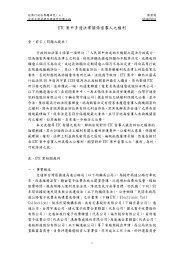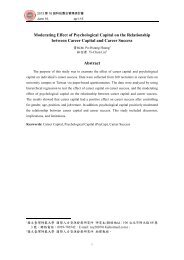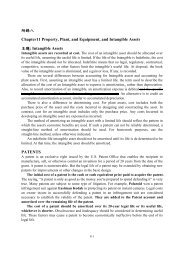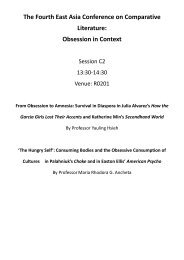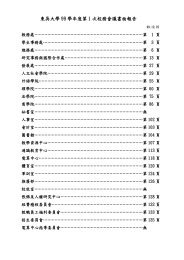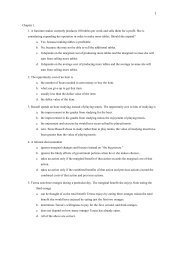The Power of the Pill: Oral Contraceptives and Women's ... - Mail
The Power of the Pill: Oral Contraceptives and Women's ... - Mail
The Power of the Pill: Oral Contraceptives and Women's ... - Mail
You also want an ePaper? Increase the reach of your titles
YUMPU automatically turns print PDFs into web optimized ePapers that Google loves.
power <strong>of</strong> <strong>the</strong> pill 743<br />
<strong>of</strong> marital status <strong>and</strong> age, could receive family planning services on<br />
campus, <strong>and</strong> o<strong>the</strong>rs could obtain <strong>the</strong>m locally without parental consent.<br />
C. <strong>The</strong> Impact <strong>of</strong> State Laws on <strong>Pill</strong> Use<br />
Did states with more lenient laws regarding access to contraceptive services<br />
by minors have higher pill use by young unmarried women? <strong>The</strong><br />
NSYW71 is <strong>the</strong> only data set, <strong>of</strong> which we are aware, that pertains to<br />
<strong>the</strong> most relevant time period (<strong>the</strong> very early 1970s) <strong>and</strong> has information<br />
on pill use <strong>and</strong> state <strong>of</strong> residence for female teenagers. 29 We have coded<br />
<strong>the</strong> respondent’s state <strong>of</strong> residence according to whe<strong>the</strong>r <strong>the</strong> state was<br />
governed by <strong>the</strong> mature minor doctrine or had a comprehensive family<br />
planning statute, both <strong>of</strong> which would have enabled young women (16<br />
years <strong>and</strong> older) to obtain <strong>the</strong> pill. Twelve states fit that description in<br />
1971, with seven states having a minimum age <strong>of</strong> 14 or 15 years (see<br />
col. 5 <strong>of</strong> table 2).<br />
<strong>The</strong> estimation in table 3 is given for all never-married women (cols.<br />
1, 3, <strong>and</strong> 5) <strong>and</strong> for those who ever had sexual relations (cols. 2, 4, <strong>and</strong><br />
6). <strong>The</strong> effect on pill use <strong>of</strong> being in one <strong>of</strong> <strong>the</strong> nonrestrictive states,<br />
relative to <strong>the</strong> mean <strong>of</strong> <strong>the</strong> dependent variable, is quite similar for <strong>the</strong><br />
two estimations. Included in <strong>the</strong> regressions are covariates for age, education,<br />
current school attendance, religion, race, <strong>and</strong> census division.<br />
States with more lenient regulations regarding minors had greater<br />
pill use by young unmarried women. For 15–19-year-olds, pill use was<br />
33–35 percent greater in less restrictive states (cols. 1 <strong>and</strong> 2); for <strong>the</strong><br />
17–19-year-olds, it was 36–40 percent greater (cols. 3 <strong>and</strong> 4). <strong>The</strong> increase<br />
was largest for all college women (col. 5), perhaps because most<br />
university health services carefully followed <strong>the</strong> law <strong>and</strong> <strong>of</strong>fered family<br />
planning services when <strong>the</strong> law changed. 30<br />
In states with more permissive laws, young women appear to have had<br />
greater access to <strong>the</strong> pill. But despite our emphasis on changes in laws,<br />
we also recognize <strong>the</strong> porosity <strong>of</strong> <strong>the</strong> laws <strong>and</strong> <strong>the</strong> role <strong>of</strong> social norms.<br />
Even before 1970, change was “in <strong>the</strong> air” regarding <strong>the</strong> rights <strong>of</strong> young<br />
people. <strong>The</strong> 1967 social security amendment allowing poor women to<br />
obtain family planning services without regard to marital status or age<br />
was a signal to physicians. States <strong>of</strong>ten had ambiguous laws that enabled<br />
county health departments to extend contraceptive services to all women<br />
29<br />
<strong>The</strong> NSAF76 does not have state <strong>of</strong> residence, <strong>and</strong>, even if it did, it would be too late.<br />
30<br />
<strong>The</strong> magnitudes <strong>of</strong> <strong>the</strong> estimated effects <strong>of</strong> a nonrestrictive state law in cols. 1–4 <strong>of</strong><br />
table 3 are not much affected by adding state per capita income to <strong>the</strong> regressions. <strong>The</strong><br />
coefficients on <strong>the</strong> state law variable for <strong>the</strong> subsample <strong>of</strong> college women in cols. 5 <strong>and</strong><br />
6 are reduced in magnitude, <strong>and</strong> <strong>the</strong> st<strong>and</strong>ard errors increased substantially, by <strong>the</strong> inclusion<br />
<strong>of</strong> state per capita income. For nonsou<strong>the</strong>rn states, <strong>the</strong> income <strong>and</strong> <strong>the</strong> state law<br />
variables are highly correlated.




